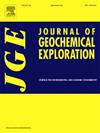Genesis of the Pulang polymetallic mineralization system in Yunnan Province, China: Insights from in situ trace element and S isotope analyses of pyrite
IF 3.3
2区 地球科学
Q1 GEOCHEMISTRY & GEOPHYSICS
引用次数: 0
Abstract
The Pulang deposit in the “Sanjiang” area of Yunan Province hosts ~4.8 × 106 tons of Cu and abundant associated metals such as Mo, Au, Ag, Pb and Zn, constituting a polymetallic porphyry system. Nevertheless, the multistage and multispace mineralization processes of these metals and the associated physicochemical evolution controlling their precipitation are still unclear. In this study, pyrite was selected from different stages and ore blocks to conduct in situ trace element, mapping (LA–ICP–MS) and S isotope analyses, to address the above issues.
The results indicate systematic variations in trace element distributions within the pyrite at Pulang, which are correlated with mineralization types (Mo, Cu, Pb![]() Zn), alteration types (potassic, phyllic, prophylitic), and spatial locations (South, North, East Pulang). These patterns reflect integrated fluctuations in fluid temperature, oxygen fugacity (fO₂), pH, and salinity during fluid evolution processes including boiling, mixing, overprinting, and fluid–rock interactions. Mapping images reveal at least three hydrothermal events in the Cu mineralization stage: event 1 (Co–Ni–Se enrichment), event 2 (Co
Zn), alteration types (potassic, phyllic, prophylitic), and spatial locations (South, North, East Pulang). These patterns reflect integrated fluctuations in fluid temperature, oxygen fugacity (fO₂), pH, and salinity during fluid evolution processes including boiling, mixing, overprinting, and fluid–rock interactions. Mapping images reveal at least three hydrothermal events in the Cu mineralization stage: event 1 (Co–Ni–Se enrichment), event 2 (Co![]() As enrichment), and event 3 (Cu–Ag–Sb–Au–Pb–Zn–Bi–Mo enrichment), with the latter exhibiting a genetic linkage to the precipitation of both Cu and Mo. The Pb
As enrichment), and event 3 (Cu–Ag–Sb–Au–Pb–Zn–Bi–Mo enrichment), with the latter exhibiting a genetic linkage to the precipitation of both Cu and Mo. The Pb![]() Zn stage records two superimposed hydrothermal events: an early Co–Sb–Te–Ni–Au-enriched event 1, overprinted by a later Cu–As–Mo–Ag–Pb–Bi–dominant hydrothermal pulse (event 2) associated with Pb and Zn precipitation. The presence of trace elements and fluctuanting δ34S values (−2.64 to 4.16 ‰) indicate that the successive precipitation of Mo and Cu in South Pulang was triggered by the efficient cooling of fluids, whereas the precipitation of Cu in East Pulang was associated with decreases in both temperature and fO2, as a result of fluid–rock interactions during the eastward migration of fluid. In contrast, in North Pulang, the decreasing Se/Ge, Co/Ni and Co/As ratios imply that the significant involvement of meteoric water during the northward migration of fluid was also responsible for the precipitation of Cu, Pb and Zn.
Zn stage records two superimposed hydrothermal events: an early Co–Sb–Te–Ni–Au-enriched event 1, overprinted by a later Cu–As–Mo–Ag–Pb–Bi–dominant hydrothermal pulse (event 2) associated with Pb and Zn precipitation. The presence of trace elements and fluctuanting δ34S values (−2.64 to 4.16 ‰) indicate that the successive precipitation of Mo and Cu in South Pulang was triggered by the efficient cooling of fluids, whereas the precipitation of Cu in East Pulang was associated with decreases in both temperature and fO2, as a result of fluid–rock interactions during the eastward migration of fluid. In contrast, in North Pulang, the decreasing Se/Ge, Co/Ni and Co/As ratios imply that the significant involvement of meteoric water during the northward migration of fluid was also responsible for the precipitation of Cu, Pb and Zn.
云南Pulang多金属成矿系统成因:黄铁矿原位微量元素和S同位素分析的启示
云南“三江”地区Pulang矿床含铜量约4.8 × 106吨,伴生金属Mo、Au、Ag、Pb、Zn丰富,构成多金属斑岩体系。然而,这些金属的多阶段、多空间成矿过程以及控制其沉淀的相关物理化学演化仍不清楚。为了解决上述问题,本研究选取了不同阶段和矿块的黄铁矿,进行了原位微量元素测绘(LA-ICP-MS)和S同位素分析。结果表明,Pulang黄铁矿中微量元素的分布具有系统的差异性,与成矿类型(Mo、Cu、PbZn)、蚀变类型(钾质、叶质、绿质)和空间位置(Pulang南、北、东)有关。这些模式反映了流体演化过程中流体温度、氧逸度(fO₂)、pH和盐度的综合波动,包括沸腾、混合、套印和流体-岩石相互作用。在Cu成矿阶段,至少有3个热液事件:事件1 (Co-Ni-Se富集)、事件2 (CoAs富集)和事件3 (Cu - ag - sb - au - pb - zn - bi - Mo富集),其中Cu - ag - sb - au - pb - zn - bi - Mo富集与Cu和Mo的沉淀具有遗传联系。早期co - sb - te - ni - au富集事件1,被后来cu - as - mo - ag - Pb - bi为主的热液脉冲(事件2)叠加,与Pb和Zn沉淀有关。微量元素的存在和δ34S值的波动(−2.64 ~ 4.16‰)表明,南Pulang地区Mo和Cu的连续沉淀是由流体的有效冷却触发的,而东Pulang地区Cu的沉淀与温度和fO2的降低有关,是流体东移过程中流体-岩石相互作用的结果。而在Pulang北部,Se/Ge、Co/Ni和Co/As比值的下降表明,流体北移过程中大气水的显著参与也导致了Cu、Pb和Zn的降水。
本文章由计算机程序翻译,如有差异,请以英文原文为准。
求助全文
约1分钟内获得全文
求助全文
来源期刊

Journal of Geochemical Exploration
地学-地球化学与地球物理
CiteScore
7.40
自引率
7.70%
发文量
148
审稿时长
8.1 months
期刊介绍:
Journal of Geochemical Exploration is mostly dedicated to publication of original studies in exploration and environmental geochemistry and related topics.
Contributions considered of prevalent interest for the journal include researches based on the application of innovative methods to:
define the genesis and the evolution of mineral deposits including transfer of elements in large-scale mineralized areas.
analyze complex systems at the boundaries between bio-geochemistry, metal transport and mineral accumulation.
evaluate effects of historical mining activities on the surface environment.
trace pollutant sources and define their fate and transport models in the near-surface and surface environments involving solid, fluid and aerial matrices.
assess and quantify natural and technogenic radioactivity in the environment.
determine geochemical anomalies and set baseline reference values using compositional data analysis, multivariate statistics and geo-spatial analysis.
assess the impacts of anthropogenic contamination on ecosystems and human health at local and regional scale to prioritize and classify risks through deterministic and stochastic approaches.
Papers dedicated to the presentation of newly developed methods in analytical geochemistry to be applied in the field or in laboratory are also within the topics of interest for the journal.
 求助内容:
求助内容: 应助结果提醒方式:
应助结果提醒方式:


